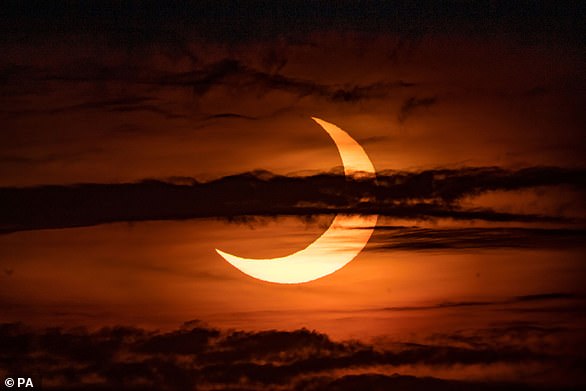Will YOU see this month’s ‘ring of fire’ solar eclipse? Interactive map reveals the areas where skygazers will have the best view of the rare astronomical event
>
This month, stargazers in the United States, Mexico and parts of South America will enjoy a dazzling view of the “Ring of Fire” solar eclipse.
This rare astronomical event will occur on October 14, when a new moon, slightly smaller than average, will block about 90 percent of the sun for about five minutes.
Better yet, for those who want to catch a glimpse of the stunning display, NASA has created an interactive map that reveals the areas set up for the best viewing.
the Eclipse Explorer It will allow people to track an annular solar eclipse down to the exact second.
This type of eclipse is when the Moon passes between the Earth and the Sun at a time when the Moon is at or near its farthest point from our planet.
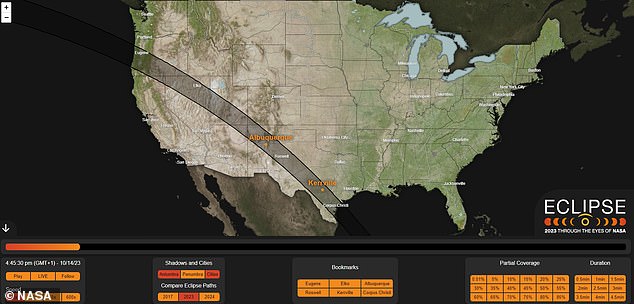
JUST THE VIEW: Stargazers in the United States, Mexico and parts of South America this month will enjoy a dazzling spectacle of the “Ring of Fire” solar eclipse. NASA’s Eclipse Explorer will allow stargazers to track it down to the exact second
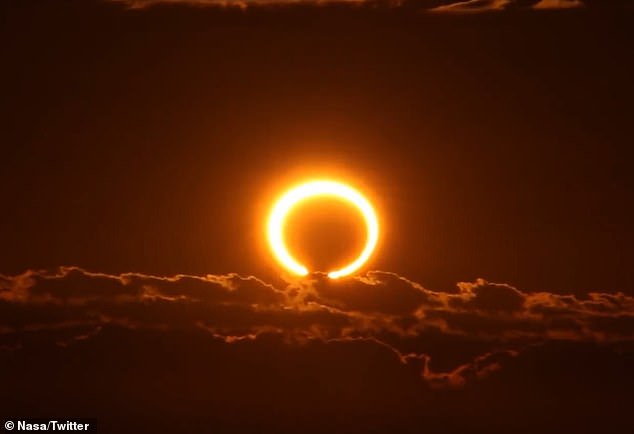
What it will look like: This rare astronomical event will occur on October 14 when the slightly smaller-than-average new moon will block about 90 percent of the sun for up to five minutes.
It does not completely obscure the face of the Sun, unlike a total solar eclipse, which is why it will momentarily appear as if a ring of fire surrounds the dark disk of the Moon.
A total solar eclipse is scheduled to occur on April 8, 2024, and will pass over Mexico, the United States, and Canada.
Meanwhile, millions of people across North, Central and South America will likely get a view of the stunning annular eclipse.
In the United States, where according to NASA, maximum solar obscuration will occur, the eclipse will pass through parts of several states starting at 09:13 PT (17:13 GMT) in Oregon.
| location | The beginning of the partial eclipse | The episode begins | Maximum | The episode ends | The end of the partial eclipse |
|---|---|---|---|---|---|
| Eugene, Oregon | 8:06 AM PT | 9:16 AM PT | 9:18 AM PT | 9:20 AM PT | 10:39 AM PT |
| Alturas, California | 8:05 AM PT | 9:19 AM PT | 9:20 AM PT | 9:21 AM PT | 10:43 AM PT |
| (Battle Mountain, Nevada). | 8:06 AM PT | 9:21 AM PT | 9:23 AM PT | 9:25 AM PT | 10:48 AM PT |
| Richfield, Utah | 9:09 AM Mecca time | 10:26 AM Mecca time | 10:28 AM Mecca time | 10:31 AM Mecca time | 11:56 AM Mecca time |
| (Albuquerque, New Mexico). | 9:13 AM Mecca time | 10:34 AM Mecca time | 10:35 AM Mecca time | 10:39 AM Mecca time | 12:09 pm Cairo time |
| San Antonio, Texas | 10:23 AM CET | 11:52 AM CET | 11:54 AM CET | 11:56 AM CET | 1:33 PM CST |
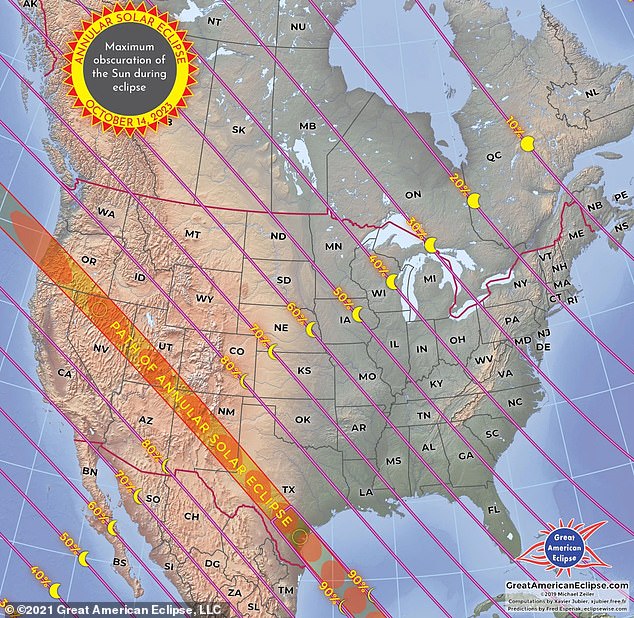
In the United States, where according to NASA, maximum solar obscuration will occur, the eclipse will pass through parts of several states starting at 09:13 PT (17:13 GMT) in Oregon.
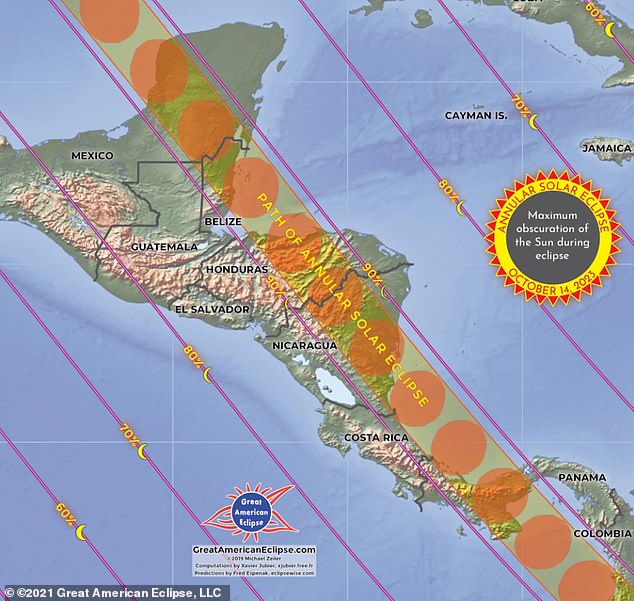
The path of the eclipse will later cross parts of Mexico, Guatemala, Belize, Honduras, Nicaragua, Panama, Colombia and Brazil before ending at sunset in the Atlantic Ocean.
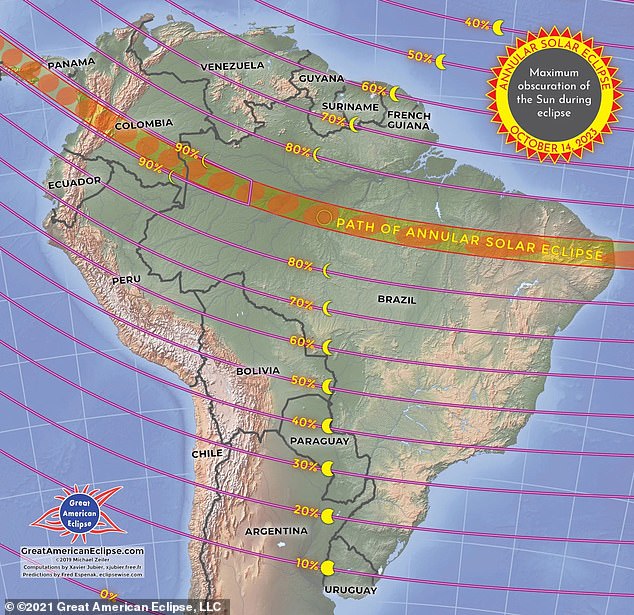
At the same time, people in much larger parts of North America, Central America and South America (pictured) will be able to see less blocking of the sun.
It will next appear in California, Nevada, Utah, Arizona, New Mexico and Texas.
The path of the eclipse will later cross parts of Mexico, Guatemala, Belize, Honduras, Nicaragua, Panama, Colombia and Brazil before ending at sunset in the Atlantic Ocean.
At the same time, people in much larger parts of North America, Central America, and South America will be able to see less obstruction of the Sun.
To help make the most of it, NASA has created a tool that it says will enable users to “dive into this incredible celestial event like never before.”
It features layers upon layers of details that space enthusiasts can turn on or off, including what percentage of the sun will be covered at the peak of the eclipse in different regions.
Skygazers can also see the path and shapes of the umbra — the darkest part of the shadow and where the annular occurs — and the penumbra, the brightest parts of the umbra, where only a partial eclipse can be seen.
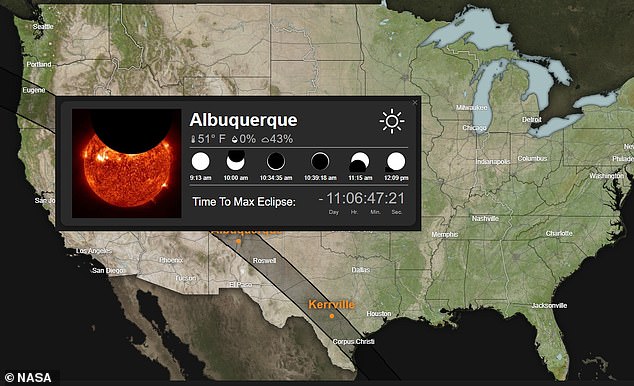
Fun to play with: NASA’s interactive widget (pictured) features layers upon layers of details that space enthusiasts can toggle on and off, including what percentage of the sun will be covered at the peak of the eclipse in different regions
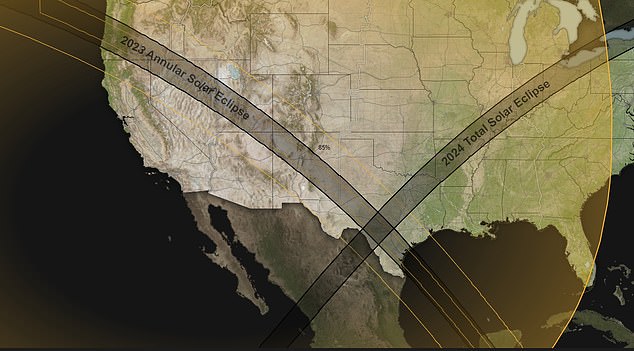
Comparison: An annular solar eclipse does not completely obscure the face of the Sun, unlike a total solar eclipse, which is why it will momentarily appear as if a ring of fire surrounds the dark disk of the Moon. Pictured is the path the annular solar eclipse of 2023 will take compared to the total solar eclipse that will be visible in 2024.
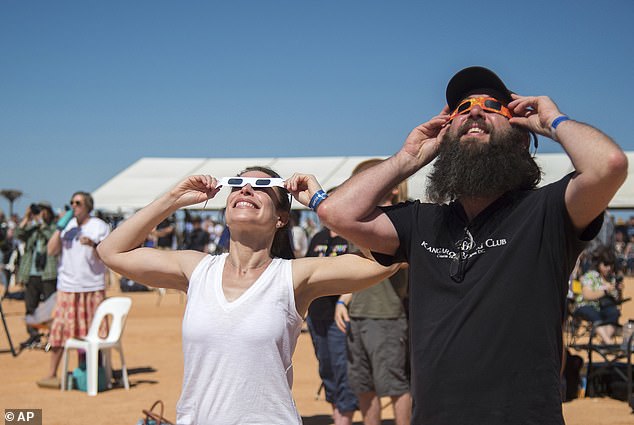
Warning: Before the spectacle, stargazers were also reminded not to look directly at the sun during the eclipse. For safe viewing, people have been advised to grab some eclipse glasses (pictured) to wear during the rare event
There’s also a “time slider” that allows people to see how the eclipse’s shadow will change across the United States, as well as city posters that reveal not only what the scene will look like in a particular location but what weather conditions are expected as well.
Other features include a so-called “countdown widget,” which provides a timer for when the eclipse will be at maximum coverage for each city.
The Autoplay button then displays how the eclipse will unfold across the country.
It can be viewed at different speeds, while a ‘Follow’ toggle will allow users to move the map to track the shadow as it moves across the landscape during the eclipse.
In a blog post on NASA’s website, NASA wrote: “The interface comes with a grid of toggle buttons at the bottom, divided into different categories: shadow components, city labels (or bookmarks), eclipse paths, coverage percentages, and time periods.”
Clicking any of the buttons will cause that data to appear (or disappear) on the map.
“In addition, clicking on any of the city labels on the map will bring up a pop-up window filled with additional information about the eclipse in that location.”
NASA plans to use the Eclipse Explorer for its live broadcast of the eclipse, which will be available here.
Before the spectacle, stargazers were also reminded not to look directly at the sun during the eclipse.
For safe viewing, people are advised to purchase some eclipse glasses to wear during the rare event.
When using a camera, telescope or binoculars, a NASA-approved sun filter is the best kit to get, experts say.
(Tags for translation)dailymail

